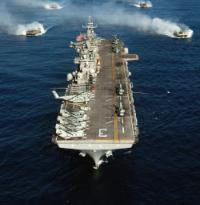In June of this year, the United States Navy published the 2010 Naval Operations Concept (.pdf) (NOC), designed as the operational fulfillment of the Cooperative Maritime Strategy (.pdf) (CS-21) released in 2007. The 112-page NOC is an elaboration of the concepts set forth in the 20-page Cooperative Strategy, with detailed discussion of how the missions laid forth in the earlier document can be accomplished with the forces available to the United States Navy. CS-21 itself is a curious document. Deceptively modest, it was developed as the Navy's strategic answer to the post-Cold War environment. But whether intentionally, as some have suggested, or not, it may have helped structure America's grand strategic approach to the emergence of new powers on the Pacific Rim and elsewhere.
CS-21, and the NOC that gives it flesh, provide a liberal internationalist frame for how the United States should interpret the rise of Chinese naval power. This frame suggests that naval competition between the United States and China could be positive sum, rather than zero sum -- the United States could actually benefit in some ways from the expansion of the Chinese navy. This stands in tension with more traditional and, in many ways, more accepted theories about the role and impact of navies in great power competition.
Toward the Cooperative Strategy

